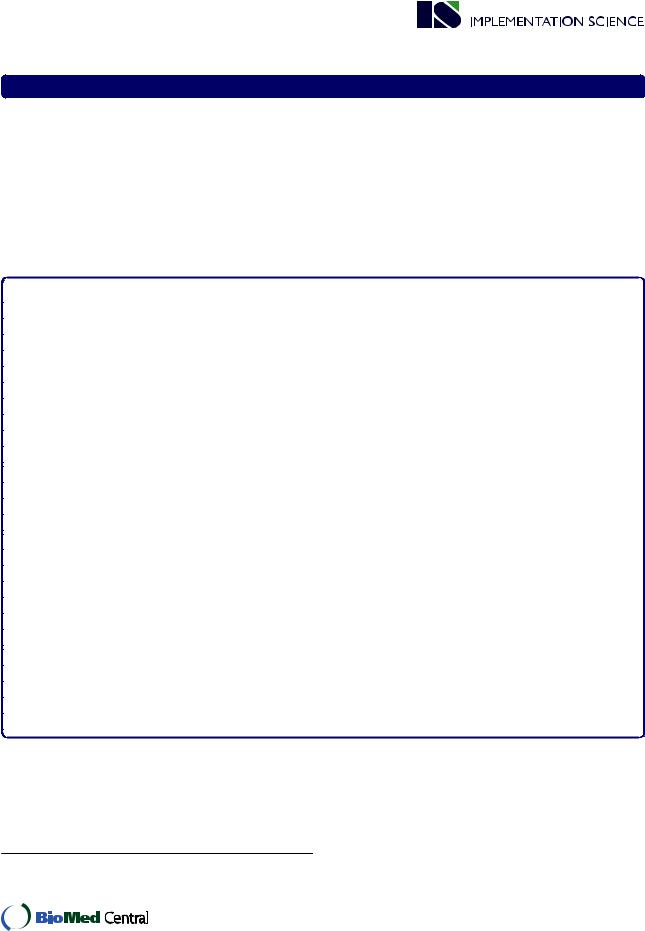
- •Abstract
- •Background
- •Methods
- •Knowledge translation concepts
- •Knowledge translation implementation
- •Relevance versus rigor in knowledge creation and adoption
- •Extending research and development outputs to production impacts
- •The CIPP model to achieve merit and worth in outputs
- •The need to knowledge model
- •Linking the CIPP model to the logic model
- •Knowledge translation and logic models
- •Results
- •Conclusion
- •Summary
- •Competing interests
- •Acknowledgments
- •References

Stone and Lane Implementation Science 2012, 7:44
http://www.implementationscience.com/content/7/1/44
Implementation
Science
METHODOLOGY |
Open Access |
Modeling technology innovation: How science, engineering, and industry methods can combine to generate beneficial socioeconomic impacts
Vathsala I Stone* and Joseph P Lane
 Abstract
Abstract
Background: Government-sponsored science, technology, and innovation (STI) programs support the socioeconomic aspects of public policies, in addition to expanding the knowledge base. For example, beneficial healthcare services and devices are expected to result from investments in research and development (R&D) programs, which assume a causal link to commercial innovation. Such programs are increasingly held accountable for evidence of impact—that is, innovative goods and services resulting from R&D activity. However, the absence of comprehensive models and metrics skews evidence gathering toward bibliometrics about research outputs (published discoveries), with less focus on transfer metrics about development outputs (patented prototypes) and almost none on econometrics related to production outputs (commercial innovations). This disparity is particularly problematic for the expressed intent of such programs, as most measurable socioeconomic benefits result from the last category of outputs.
Methods: This paper proposes a conceptual framework integrating all three knowledge-generating methods into a logic model, useful for planning, obtaining, and measuring the intended beneficial impacts through the implementation of knowledge in practice. Additionally, the integration of the Context-Input-Process-Product (CIPP) model of evaluation proactively builds relevance into STI policies and programs while sustaining rigor.
Results: The resulting logic model framework explicitly traces the progress of knowledge from inputs, following it through the three knowledge-generating processes and their respective knowledge outputs (discovery, invention, innovation), as it generates the intended socio-beneficial impacts. It is a hybrid model for generating technologybased innovations, where best practices in new product development merge with a widely accepted knowledgetranslation approach. Given the emphasis on evidence-based practice in the medical and health fields and “bench to bedside” expectations for knowledge transfer, sponsors and grantees alike should find the model useful for planning, implementing, and evaluating innovation processes.
Conclusions: High-cost/high-risk industries like healthcare require the market deployment of technology-based innovations to improve domestic society in a global economy. An appropriate balance of relevance and rigor in research, development, and production is crucial to optimize the return on public investment in such programs. The technology-innovation process needs a comprehensive operational model to effectively allocate public funds and thereby deliberately and systematically accomplish socioeconomic benefits.
* Correspondence: vstone@buffalo.edu
Center on Knowledge Translation for Technology Transfer, University at Buffalo (SUNY), New York, NY, USA
© 2012 Stone and Lane; licensee BioMed Central Ltd. This is an Open Access article distributed under the terms of the Creative Commons Attribution License (http://creativecommons.org/licenses/by/2.0), which permits unrestricted use, distribution, and reproduction in any medium, provided the original work is properly cited.
